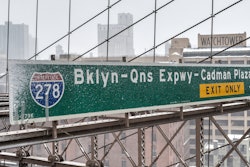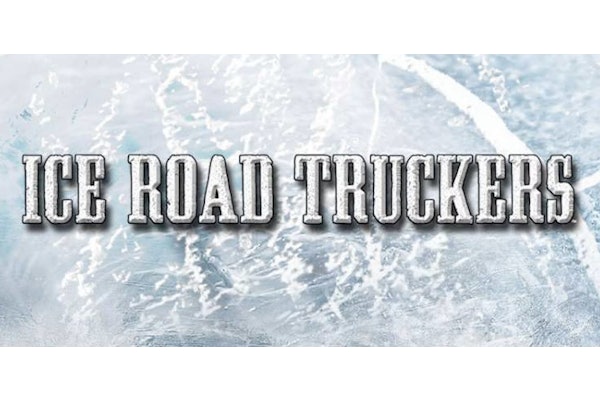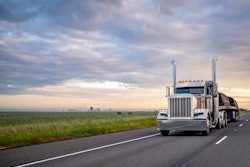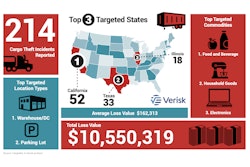Three leading senators from the Northeast are calling on the makers of popular smartphone navigation apps to add data to help prevent incidents of trucks striking low bridges on prohibited routes. The president of one state trucking association is praising the suggestion, calling it a “commonsense” solution that ought to be easy to implement.
Sen. Richard Blumenthal, D. Conn., Monday, Jan. 13, called on the makers of GPS apps for smartphones to add what he called “commonsense info on highway height, weight, and other restrictions” to their navigation apps so truckers do not enter Merritt and Wilbur Cross Parkways. Trucks are not allowed on the parkways — and those in neighboring New York, Massachusetts, and New Jersey — but some drivers follow the directions on the apps, which don’t necessarily show truck restrictions.
 Sen. Richard Blumenthal at a press conference Monday, Jan. 13 about the need for more truck-related information on popular GPS apps for smartphones.
Sen. Richard Blumenthal at a press conference Monday, Jan. 13 about the need for more truck-related information on popular GPS apps for smartphones.In a news conference and separately in a letter sent Monday with Sen. Chuck Schumer, D-N.Y., and Ed Markey, D-Mass., Blumenthal called on tech giants Google, Apple and Waze to include information that would keep trucks off restricted parkways and reduce collisions with low-bridges.
“As more commercial vehicle drivers use these applications, we can expect accidents and damage to roadways to increase unless a solution is found,” said the letter from the senators. Blumenthal said truckers and others often rely on the apps to route them around traffic congestion on other routes and ignore or do not see signs warning against truck traffic on the parkways.
Vehicles taller than 8 feet, longer than 24 feet or wider than 7 1/2 feet or weigh more than 7,500 lbs. are not allowed on the parkways in Connecticut, for example.
Joseph Sculley is the president of the Motor Truck Association of Connecticut and said he was heartened to see Blumenthal “put a commonsense idea on the table” to address the issue that can be a public relations problem for the trucking industry. Sculley said that while members of the MTAC know to avoid the parkways, the problem is usually caused by out-of-state truckers who may not be using truck-specific GPS units.
“Every time a truck gets stuck (under a low bridge on a parkway) it makes headlines, and the PR is not good for trucking,” said Sculley. He said adding the information ought to be easy for the tech companies to do, and his 550-member organization expects to work with others to make it happen.
Earlier this month Schumer also called on GPS makers to include at-grade railroad crossing information to their programs. In a letter to 10 technology companies, including Google, the senior senator from New York reminded them the National Transportation Safety Board in 2016 recommended such information be included following an accident in California that took the life of an engineer and injured 32 others. Schumer said there are 5,358 at-grade railroad crossings in New York alone.
A number of people made comments on the Blumentah’s Facebook page following Monday’s press conference.
Wendy Bly: “Unfortunately, it is the drivers at fault, not the application. I drive an RV, and know that the regular GPS systems for cars do not take into account for height clearance. Professional truck drivers should also know that there are special applications for trucks that do list heights… it’s a matter of ignorance or being cheap (trucker app is more expensive). Also, any time there is a clearance issue, signage on the road is clearly posted with enough notice… It is sad that our government has to do our thinking for us…”
Alfred Craig Jenkins: “Pardon me! But as a CDL license holder. We’re taught that (parkways) aren’t for any type of bus or trucks … period. Any truck driver that’s using that excuse shouldn’t be driving.”
William Hau: “I think this is a great idea. I tow a smallish boat and any mistake with a bridge would be a very expensive one. I thought the truck drivers had dedicated GPS devices that already had this. I can assure you no 18 wheeler wants to be on the parkway.”
Patricia Demers Suski: “There are signs for NO commercial vehicles. The truck drivers should be responsible! GPS make errors. Mine has told me to go down a road that doesn’t exist. Do I? Of course not. The driver needs to use common sense. Let’s stop blaming everyone/everything else.
Cliff Kelsey: “Drove truck all over the USA with only paper maps. (C)ommon sense is what’s lacking. (T) here are maps and books that show restricted routes and low underpass.”
Kyrra Gelinas: “This is literally the dumbest thing ever. Waze has options that let you put in what kind of vehicle you’re driving. There are signs leading up to the Merritt that SAY no commercial vehicles. How about adding common sense DRIVERS to the road?”
Brian Worth Sr.: “Low clearance needs to be posted in Russian and about 12 different languages or we could make CDLs contingent on a mastery of basic English.”
Tom Brown: “What happened to reading all the signs, knowing your truck height and so on. You need to take responsibility if you’re driving and not blame it on the GPS!”
Mario Caiti: “Why doesn’t Waze have a trucker mode?!?!?! They have the best and brightest building their app and they plain forgot about trucks.”
Salvatore Lanzieri: “What I don’t understand is why people driving trucks don’t put GPS on truck mode!?!?!? I drive truck and use it especially when I’m not really too familiar with (the) area. GPS has stopped me more than once from getting on Taconic State (Parkway) in New York.
Stephanie Pinto Johnson: “If the gigantic signs that state “No Trucks” don’t trigger a common-sense response, I’m not sure what Google, Apple and Waze are going to do.”
Timothy Rourke: “Agree! Seems silly Google has not added vehicle profile info. I have ended up on low-clearance parkways with our RV that prompted some emergency lane changes. Not safe.”
Richard Ciotti: “I can’t say I buy this excuse. If you just slavishly follow GPS, without reviewing the route ahead of time, and know so little about the area that you aren’t aware of height restrictions, maybe you shouldn’t be on the road.”
Truckers News has contacted Google, Apple and Waze for comment and has yet to hear from them. We’ll add their responses when/if they are received.
The number 1 excuse from truck drivers that get stuck on the Merritt-Wilbur Cross Parkways is a GPS directed them there. I join law enforcement officials in calling on Google, Apple&Waze to add commonsense info on highway height, weight&other restrictions to their navigation apps pic.twitter.com/MsTAkIGAIv
— Richard Blumenthal (@SenBlumenthal) January 13, 2020
___
David Hollis is editor of Truckers News and can be reached at [email protected] .












